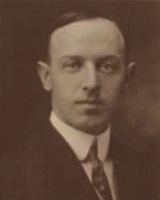Succeeded by Joseph C. Shaffer Role U.S. representative Battles and wars World War I | Preceded by Henry C. McDowell Preceded by Joseph C. Shaffer Name John Jr. Resigned August 1, 1958 | |
 | ||
John Paul Jr. (December 9, 1883 – February 13, 1964) was a U.S. Representative from Virginia, and later a United States federal judge.
Contents
Early life and education

The younger John Paul was born in Harrisonburg, Virginia, soon after his father, John Paul, who had been a Confederate soldier, Readjuster Democrat and United States Representative had become a United States federal judge after nomination by President Chester A. Arthur and confirmation by the Senate. They lived on the family's farm in Rockingham County, Virginia, and young Paul attended private and public schools. He graduated from the Virginia Military Institute in Lexington in 1903, with a degree in civil engineering, and was an instructor in that institution in 1903 and 1904. He received his Juris Doctor from the University of Virginia School of Law in 1906.
Early legal career and military service
Paul graduated from the law department of the University of Virginia at Charlottesville in 1906, was admitted to the bar and began following in his father's footsteps by setting up a private legal practice in Harrisonburg, Virginia, in 1907, which he continued for a decade 1917. A Republican in a state dominated by the Byrd Machine, Paul nonetheless was elected to the Virginia State Senate, and served two terms from 1911 to 1915, developing a cordial relationship with Byrd. Paul, however, lost races for a seat in the U.S. House of Representativesf in 1916 and 1918.
Not long after the outbreak of the First World War Paul joined the United States Army. He served with the Three Hundred and Thirteenth Field Artillery of the One Hundred and Fifty-fifth Field Artillery Brigade, and participated in the American Expeditionary Forces from May 1918 to May 1919.
Upon returning to Virginia, Paul was again elected to the State Senate, serving from 1919 to 1922. From 1919 to 1923, Paul also served Harrisonburg's city attorney. In 1920, Paul successfully contested as a Republican the election of Thomas W. Harrison to the Sixty-seventh Congress from Virginia's 7th congressional district, but Harrison presented credentials as a Member-elect and served from March 4, 1921, to December 15, 1922. Paul successfully contested this election and was awarded the seat, but he only served from December 15, 1922, to March 3, 1923. Paul's 1922 bid for reelection, to the Sixty-eighth Congress was unsuccessful, as Harrison regained the seat at the ballot box.
Paul also served as special assistant to the Attorney General of the United States, Harry M. Daugherty, in 1923 and 1924, before resuming his private practice from 1924 to 1929. Paul was also a delegate to the Republican National Conventions in 1912, 1916, 1920, and 1924. In that year, he became the United States Attorney for the Western District of Virginia, and continued in that position until 1932.
Federal judicial service
President Herbert Hoover on December 15, 1931, nominated Paul to a seat on the United States District Court for the Western District of Virginia vacated by Henry C. McDowell. The United States Senate confirmed Paul's nomination on January 11, 1932, and he received his commission on January 14, 1932. When he went to the bench, he was the only judge in the Western District, which included seven courthouses and ranged from Cumberland Gap through the Shenandoah Valley to Winchester, Virginia.
Judge Paul presided over the 50-day trial of the Franklin County moonshine conspiracy, said to be the longest trial in Virginia history to that time.
A second judgeship for the district was added in 1938. After the failed nomination of Floyd H. Roberts, and the brief tenure of Professor Armistead Mason Dobie who went on to the Court of Appeals, the position that was ultimately filled by Judge Alfred D. Barksdale, with whom Paul worked as the only two judges for the District for over 17 years.
To Paul and his colleagues fell the task of implementing the Supreme Court's decision in Brown v. Board of Education in desegregation lawsuits in the Western District of Virginia. Paul sat on the panel that ordered the integration of the graduate schools of the University of Virginia in the Gregory Swanson case, and he ordered the desegregation of the schools in the City of Charlottesville, Grayson County, and Warren County. A. Willis Robertson, a Byrd ally, called him a dispenser of even handed justice.
Paul served as chief judge from 1948 to 1958. He announced his retirement and took senior status on August 1, 1958 (as Byrd also was exploring a tentative decision to retire), but Paul also announced that he would continue to sit until a successor was appointed.Dwight D. Eisenhower nominated Theodore Roosevelt Dalton to replace him. Paul continued in service as a judge on an assigned basis as well as operating his farm in Rockingham County, Virginia. In 1961, Paul donated part of his family's farm to become the Paul State Forest.
Paul died at Ottobine, Virginia, February 13, 1964, and was interred in Woodbine Cemetery, Harrisonburg, Virginia.
